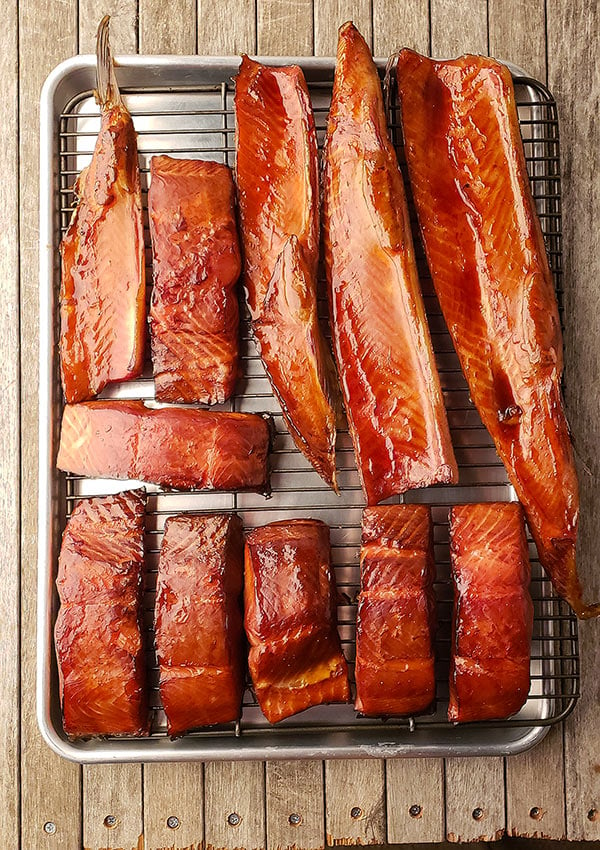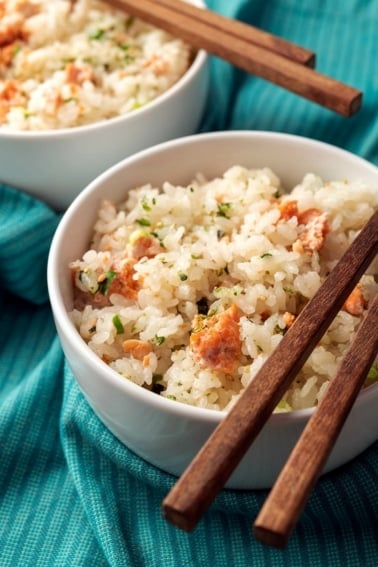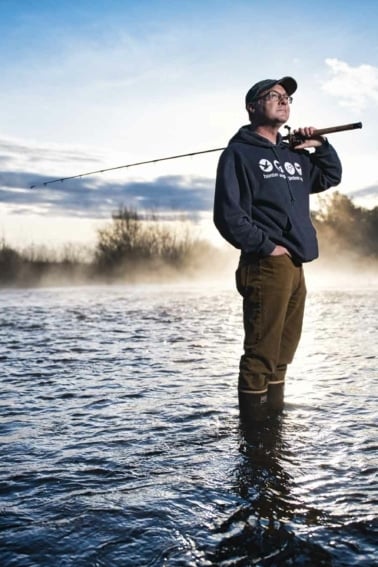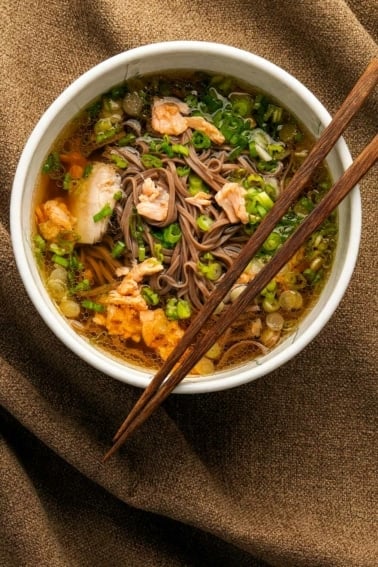As an Amazon Associate I earn from qualifying purchases.

I smoke a lot of salmon, and I am proud of this recipe, although it would be the height of arrogance to say that what I do is the end-all, be-all of salmon smoking recipes. Lots of people smoke their salmon in lots of ways, and many of them are good. But I’ve been smoking fish for many years, and I’ve developed a system that works well.
Keep in mind this is a hot-smoking recipe. Cold smoking, which is the kind of slice-able smoked fish you get in fancy boxes from Scotland is an entirely different thing.
Almost everyone in Salmon Country hot smokes their fish. If you’re unfamiliar with hot-smoked fish, think about those golden smoked whitefish you see in delicatessens; those are hot smoked.
How do you eat it? Well, you can just eat it plain, or you can flake it and make it into a smoked salmon salad, you can pound it with butter and make salmon rillettes, serve it in deviled eggs, tossed with pasta… you get the point.
Here’s what you need to get started:
- A smoker. I’ve uses a Traeger and a Bradley. Both are good. No matter what smoker you use, you will need to be able to a) know your smoking chamber’s temperature, and b) control the heat, at least in a rough sense.
- Wood. The only downside to a Traeger smoker is that you need to use their wood pellets. As a guy who used a Brinkmann wood-fired BBQ for years, fueling it with scraps of almond and other fruit woods, buying wood can be annoying, but you get better precision with this method. I prefer to use alder wood for my salmon, but apple, cherry, oak or maple work fine.
- Salt. Buy a box of kosher salt from the supermarket. Do not use regular table salt, as it contains iodide and anti-caking agents that will give your salmon an “off” flavor. I use Diamond Crystal, which is cut finer than Morton’s.
- Something sweet — salmon love sweet. I prefer to sweeten my smoked salmon with birch syrup; It’s just like maple syrup, only tapped from birch trees instead. Super cool stuff. But maple syrup is just as good. Just use real maple syrup, OK? Not the imitation crap. Honey works, too.
- A large plastic container. Buy the big, flat ones from the supermarket. They stack easily in a normal fridge, so you can have two different brines going. And they clean easily and are pretty cheap.
- A wire rack. You need to rest your brined fish on a rack with plenty of air circulation to form the all-important pellicle (more on that in a bit), and you will use it to rest the smoked fish before storing it.
- A basting brush. You probably already have this in your kitchen, but if not, pick one up. Get the flat kind, like you use to paint detail on window trim.
When you are ready to start, you will need smallish pieces of salmon about 1/4 to 1/2 pound each. Any salmonid fish will work with this recipe. I’ve done it with king salmon, sockeye, coho, and pink salmon, dolly varden, plus kokanee, steelhead and Lahontan trout.
There is no reason it would not work with chum salmon or any other char or trout species. And yes, it works with farmed Atlantic salmon, but I never eat the stuff.
I prefer to smoke salmon with its skin on, but I’ve done it with skinless pieces and it works fine.
Smoked Salmon
Ingredients
- 5 pounds salmon, trout or char
- Birch or maple syrup for basting
BRINE
- 1 quart cool water
- 1/3 cup Diamond Crystal kosher salt, about 2 ounces of any kosher salt
- 1 cup brown sugar
Instructions
- Mix together the brine ingredients and place your fish in a non-reactive container (plastic or glass), cover and put in the refrigerator. This curing process eliminates some of the moisture from the inside of the fish while at the same time infusing it with salt, which will help preserve the salmon.
- You will need to cure your salmon at least 4 hours, even for thin fillets from trout or pink salmon. In my experience, large trout or char, as well as pink, sockeye and silver salmon need 8 hours. A really thick piece of king salmon might need as much as 36 hours in the brine. Never go more than 48 hours, however, or your fish will be too salty. Double the brine if it's not enough to cover the fish.
- Take your fish out of the brine, rinse it briefly under cold running water, and pat it dry. Set the fillets on your cooling rack, skin side down. Ideally you'd do this right under a ceiling fan set on high, or outside in a cool, breezy place. By "cool" I mean 60°F or cooler. Let the fish dry for 2 to 4 hours (or up to overnight in the fridge). You want the surface of the fish to develop a shiny skin called a pellicle. This is one step many beginning smokers fail to do, but drying your cured, brined fish in a cool, breezy place is vital to properly smoking it. The pellicle, which is a thin, lacquer-like layer on top of the fish, seals it and offers a sticky surface for the smoke to adhere to. Don't worry, the salt in the brine will protect your fish from spoilage. Once you have your pellicle, you can refrigerate your fish for a few hours and smoke it later if you'd like.
- Start by slicking the skin of your fish with some oil, so it won't stick to the smoker rack. Know that even though this is hot smoking, you still do not want high temperatures. Start with a small fire and work your way up as you go. It is important to bring the temperature up gradually or you will get that white albumin "bleed" on the meat. I can control my heat with my smoker, so I start the process between 140°F and 150°F for up to an hour, then finish at 175°F for a final hour or two. NOTE: What my smoker is set at is not necessarily what the actual temperature is. Smoking is an art, not a science. To keep temperatures mild, always put water in your drip pan to keep the temperature down. If your smoker is very hot, like a Traeger can get, put ice in the tray.
- After an hour in the smoker, baste the fish with birch or maple syrup, or honey; do this every hour. This is a good way to brush away any albumin that might form. In most cases, you will get a little. You just don't want a ton of it. Even if you can't control your temperature this precisely, you get the general idea. You goal should be an internal temperature of about 130°F to 140°F. (Incidentally, yes, I keep the smoke on the whole time. I don't find this to be too much smoke, but if you want a lighter smoke, finish the salmon without smoke or in a 200°F oven.)
- You must be careful about your heat. Other than failing to dry your salmon long enough, the single biggest problem in smoking salmon is too high heat. If you've ever seen salmon "bleed" a white, creamy substance, that's a protein called albumin. If you see lots of it, you've screwed up; a little is normal. Here's what happens: If you cook a piece of salmon at too high a heat, the muscle fibers in the meat contract so violently that they extrude albumin, which immediately congeals on the surface of the fish. It's ugly, and it also means your salmon will be drier than it could have been. You prevent this with a solidly formed pellicle, and by keeping your heat gentle. If you let your heat get away from you and you do get a white mess on your salmon, all is not lost. Just flake it out and make salmon salad with it: The mayonnaise in the salad will mask any dryness.
- Once your fish is smoked, let it rest on the cooling rack for an hour before you put it in the fridge. Once refrigerated and wrapped in plastic, smoked fish will keep for 10 days. If you vacuum-seal it, the fish will keep for up to 3 weeks. Or freeze your fish for up to a year.
Notes
Nutrition
Nutrition information is automatically calculated, so should only be used as an approximation.






Dean: Huh. It should be pretty dry by now. Is it sticky or wet? If it’s just sticky, go ahead and start smoking. If you are worried, start the smoker temp low and work your way up. And if the albumen forms, paint it off with the maple syrup.
ok, i’m getting worried, i’ve had this fish(sockeye) drying for almost 4 hours now with a fan on it and the pellicle has not even begun to form, it’s still very slick to the touch. My only thought is that maybe due to the fact that i live in florida and the humidity today is like 135% that even with the fan on high it’s still gonna take a bit longer to form. does that make sense to anyone else? HELP! i’ve got my charcoal smoker all fired up and just about ready to cook. maybe i’ll just cook some steaks in the meantime while i wait for a reply. thanks folks.
Great recipe with very helpful side comments. We added bay leaves to the brine which was a subtle touch, thanks. Your pictures were helpful as well. Used your recipe twice now. We have a Big Green Egg and our fire was too hot on our first attempt. (Too much charcoal and the temperature kept getting away.) While the “attempt one salmon” was a little overcooked for a dinner entree, it was delicious with cream cheese and capers on crackers. Our second attempt began with a smaller fire and we were able to keep the temperature down. A remote thermometer is a must! Attempt 2 was much better, but the flavor was not as smoky as we would have liked. Your recipe is great and I’m sure we will improve with each attempt. This is a keeper! Thanks for posting.
I followed your directions to a T and my fish came out of the smoker perfect. Thanks for the post!
Sandra: Nope, I don’t rinse the fish.
You don’t say anything about rinsing your salmon before putting it on the drying rack. Do you?
Mark: Nope. I always do a full smoker batch, but even when I don’t, I find I still need the long smoking time.
Do I need to reduce the cooking time if I’m doing less fish?
I have done the brining overnight and have 4.5 lbs of king salmon on my Masterbuilt propane fired water smoker. The original piece of junk thermometer has been replaced with a good accurate one, but only ‘starts’ at 140 degrees. There are 5 very small chunks of soaked hickory in the ‘wood box’ with the rest filled with apple chips. I can barely keep the flame lit and keep it at 140 and at that temp, I am not getting any visible smoke.
We’ll see in several more hours, but I am hoping to get a little smoke at 175. Oh, BTW I am not a sweet freak at all so I mist the salmon with a 50/50 mix of apple juice and pure maple syrup. Wish me luck.
I had a problem with flies when air drying so I built a fish dryer. https://www.jimslounge.com/fish_dryer/
Your recipe is awesome I used more salt and brown sugar and added a little molasses the salmon is to die for.
Hank- thank you so much for sharing your amazing recipe! I grew up in Seattle eating smoked salmon my whole life. Had never made it. Now live in southern Cali. No smoked salmon around.purchases a little cheif smoker, and some sockeye filets at costco, followed your recipe to a t! And it produced the best smoked salmon I have ever eaten ! 1/4 of the cost of purchasing at Pike place! Beautiful amber color, no albumin!! Thanks again for the amazing recipe!! Bea
just wondering…. this is my first time smoking.. it seems to me it would be inefficient to open up the smoker and baste the fish every hour especially when you say the importance of the pellicle so the fish is not wet.. I’m confused by this I’ve read a few smoked salmon recipes and none say to ‘baste’ it can someone please explain??
a little more info: i have a little chief electric smoker with no temp. gauge..i have about 20lbs of fresh Chinook (spring, king whatever you want to call it) i followed the recipe above, with the exception of a few pieces i cracked some black pepper over, i am using half soaked half dry apple chips n chunks its rainy and windy today so i cut a big cardboard box to keep the heat in and also set a piece of ply wood over 2 sawhorses to cover the smoker any other suggestions?
TO all those who can’t get low temps. Suggestions :
OPEN VENTS 100%
OPEN doors a crack
get a digital thermometer so you know the temps
Very satisfied with the recipe. I did have a problem with the drying process. Perhaps, it was too warm in the house (72.5 F). I did not get the milky white layer. I kept the temp close to 200 for 2.5 hrs. I did get the white juice.
Next time, I will make some adjustments.
None the less, freaking good! Thanks for the hints and pictures.
Couldn’t keep the temps as low as suggested. I wound up smoking at about 130 F for 3 hours, then about 145 F for another 2, then finished at 175 F. (I had to leave the door cracked to achieve the lower temps with a Camp Chef Smoke Vault.) Turned out great, nonetheless. Thanks for the great brine and advice.
I am a commercial fisherman (fisherwoman) with my dad in the summer. So, as a perk, I get to take home some sockeye at the end of the season to last us the year. I was spring cleaning our freezer and I found way more fish than I thought we had. I used your recipe, to try my hand at smoking, and it turned out amazing. It was easy to follow and the fish was perfect the first time. The only downside was that I smelled like smoke even after a long shower. Evidently my husband loved the fish and loved the smoky smell in my hair, so it all worked out perfectly. I will be doing this lots more… Thanks so much!
Hi Hank,
I am a relative novice to smoking, but I made this and my family LOVED it! Even my girlfriend who “doesn’t like salmon” loved it and has asked me to make it again! I am going to make this again, I would like to dry it in the cool morning and cook it later in the day. Can I dry it in the morning, refrigerate it, then smoke it later in the day?
Thanks,
Greg
Thanks for the pointers Hank. I’ve been smoking a range of different things, mostly pork and duck, for about a year now. I live near the Snowy Mountains in Australia, where there are loads of trout and I’ve been wanting to give them a go. I dry cure the other things I’ve been smoking, so it’s nice to see how you do it. Keep up the good work!
Hank, got another dumb question.
The salmon steak 1.5lbs turns out it is skinless. the other salmon I bought has skin on. Should on smoke the skinless steak on foil?
Thanks Perry
Laurel: I keep the smoke on the whole time.